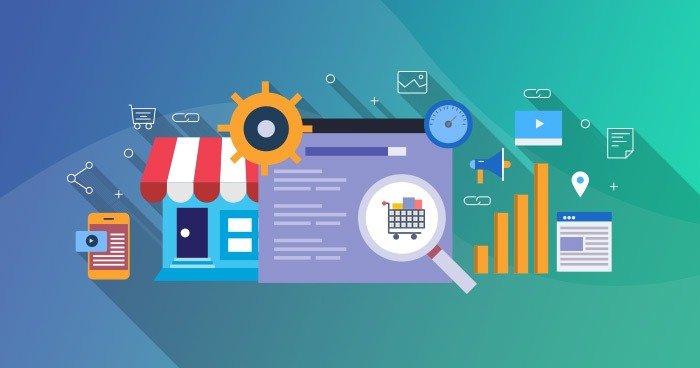What is eCommerce SEO?
eCommerce SEO (Search Engine Optimization) is the process of optimizing an online store to improve its visibility in organic search results. It focuses on bringing targeted traffic to product and category pages by improving search rankings on platforms like Google.
Unlike general SEO, which often emphasizes blog content or service pages, eCommerce SEO is built around optimizing large-scale product catalogs, filtering systems, and transactional pages. It ensures your potential customers find your products exactly when they’re ready to buy.
Why eCommerce SEO Matters for Online Stores

In a digital world where over 40% of all product discovery begins on search engines, SEO for online stores is no longer optional—it’s essential. Without visibility on search engines, your products are invisible to the very people searching for them.
While paid ads can deliver traffic, they stop working the moment your budget dries up. On the other hand, organic traffic generated through eCommerce SEO continues to flow consistently with the right foundation in place. It offers:
- Lower customer acquisition costs
- Higher return on investment over time
- Improved user trust through non-paid visibility
- Better long-term brand authority
If you’re relying solely on ads or social media, you’re missing a critical channel that shoppers use every day.
Core Elements of a High-Impact eCommerce SEO Strategy
1. Strategic Keyword Research

Effective eCommerce SEO starts with selecting the right keywords. These aren’t just high-volume terms—they’re buyer-intent queries like:
- “Buy minimalist running shoes online”
- “Organic baby clothes free shipping”
- “Best budget DSLR for beginners”
You should also use LSI keywords—terms closely related to your main keywords—to build topical relevance. For example, if you’re targeting “wireless headphones,” LSI phrases might include “Bluetooth earbuds,” “noise cancelling,” and “best over-ear headphones.”
In addition, understanding how Google Page Rank influences search visibility can help you prioritize which keywords and pages to optimize first. Pages with higher Page Rank tend to pass more authority to linked product pages, making strategic keyword placement even more critical.
Prioritize a mix of:
- Short-tail keywords (e.g., “laptop bags”)
- Long-tail keywords (e.g., “durable laptop bags for travel”)
- Informational keywords for blog content (e.g., “how to choose a laptop bag”)
These keywords fuel not just your product pages, but blog content, internal linking strategies, and more.
2. Product Page Optimization

Product pages are the cornerstone of eCommerce SEO. Every individual page should be optimized to match both search intent and conversion needs.
Best practices include:
- Use of primary keywords in product titles and headers (H1, H2)
- Unique, benefit-driven product descriptions—avoid using manufacturer content
- Adding optimized alt tags to all images
- Clear CTAs (Add to Cart, Buy Now) near the top of the page
- Incorporating customer reviews for fresh, trustworthy content
- Using schema markup for enhanced listings (e.g., ratings, price, stock status)
A well-optimized product page doesn’t just rank—it converts.
3. Technical SEO Enhancements

Behind every successful eCommerce store is a technically sound website. If your site is slow, disorganized, or not mobile-friendly, even the best keywords won’t help.
Here are the top technical areas to prioritize:
- Page Speed: Online shoppers are impatient. Optimize images, enable caching, and use a CDN to keep load times under 2 seconds.
- Mobile Optimization: With most eCommerce traffic coming from mobile, your store must be fully responsive and easy to navigate on all devices.
- HTTPS Security: Google favors secure sites, and so do users.
- Canonical Tags: These help prevent duplicate content issues caused by product variants, filters, and sorting options.
- Clean URLs: URLs should be readable and include relevant keywords (e.g.,
/black-leather-sneakersinstead of/product123?id=54782).
Conducting a comprehensive SEO Audit is the best way to identify technical issues that could be holding your site back. Regular audits using tools like Screaming Frog, Ahrefs, or Google Search Console help detect crawl errors, broken links, duplicate content, and indexing problems before they affect your rankings or user experience.
Content Marketing for eCommerce SEO

While product pages focus on converting ready-to-buy visitors, content marketing helps attract users earlier in the funnel. This is especially powerful for ranking in informational and comparative search queries.
Examples of effective content for eCommerce sites:
- Buying Guides: “How to Choose the Right Gaming Monitor”
- Product Comparisons: “Top 5 Fitness Trackers Compared: Fitbit vs Garmin vs Whoop”
- How-To Blogs: “How to Maintain Leather Shoes for Longevity”
- Gift Guides: “Best Father’s Day Gifts Under $50”
These not only help you rank for a broader set of keywords but also build topical authority in your niche. Bonus: You can link strategically to your product or category pages within each post to improve internal linking and boost rankings.
Link Building for Online Stores

Acquiring backlinks to commercial pages is difficult—but necessary. Backlinks are one of Google’s top-ranking signals, and building a solid profile of quality links can dramatically increase your visibility.
For eCommerce, link building can include:
- Partnering with influencers for product reviews and unboxing content
- Creating content assets like lookbooks or seasonal trend reports
- Guest blogging on niche sites to earn relevant links
- Submitting to directories or industry-specific lists
Even a few high-authority backlinks can make a big difference, especially if you’re in a competitive product category.
Conversion Matters: SEO + UX

Driving traffic is just half the job. If your site doesn’t convert, all that SEO effort is wasted.
Ensure your store is built for conversion with:
- Clear product descriptions and specs
- Trust signals like SSL badges, return policies, and secure checkout
- High-quality product images with zoom functionality
- Simple navigation and intuitive filtering
- Fast, guest-friendly checkout
Combining SEO with a strong UX ensures that more visitors become customers—which is the real goal.
Conclusion
eCommerce SEO is the foundation of sustainable growth for online stores. It helps your site rank higher, attract more traffic, and turn browsers into buyers—without relying solely on paid advertising.
Whether you’re a solo entrepreneur or managing a large product catalog, investing in SEO is one of the smartest long-term strategies for success. By focusing on keyword research, optimizing product pages, fixing technical issues, and publishing strategic content, you’ll build an online presence that continues to grow—even when your ad spend stops.
To keep your site’s SEO performance on track, regularly monitor your metrics using tools like Google Search Console. It provides valuable insights into indexing status, keyword visibility, crawl errors, and more—helping you refine your SEO strategy over time.




